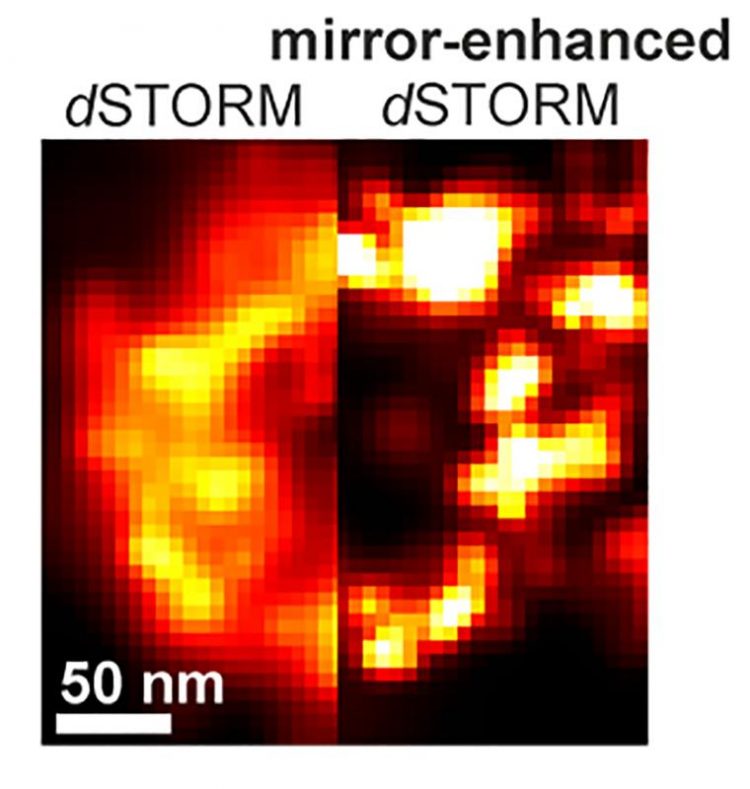New method gives microscope a boost in resolution

Conventional (left) and mirror-enhanced dSTORM (right) images of a single NPC rings. Julius-Maximilians-Universität Würzburg
The sharpness of a light microscope is limited by physical conditions: structures that are closer together than 0.2 thousandths of a millimeter blur into each other – they can no longer be distinguished from each other.
The cause of this blurring is diffraction: In simple terms, it prevents that light rays can not be bundled with arbitrary precision. Each point-shaped object is therefore not shown as a point, but as a “blurry spot”.
With mathematical methods, the resolution can still be drastically improved. One would calculate its exact center from the brightness distribution of the “blurry spot”.
However, it only works if two closely adjacent points of the object are initially not simultaneously but subsequently visible, and are merged later in the image processing. This temporal decoupling prevents superimposition of the “blurry spot”.
Researchers in life sciences have been using this tricky method for some years, for super high-resolution light microscopy of cells.
One type of this method was developed in the research group of Prof. Dr. Markus Sauer at the University of Würzburg: direct stochastic optical reconstruction microscopy (dSTORM). This powerful SMLM technique can provide a lateral resolution of ~ 20 nm.
For this purpose, certain structures – for example a pore of a cell nucleus – are stained with fluorescent dyes. Each of the dye molecules blinks at irregular intervals and represents part of the pore. The image of the complete nuclear pores is therefore not initially visible, but arises after the image processing by the superposition of several thousand images.
With the dSTORM technique, the resolution of a conventional light microscope can be increased by a factor of ten. “It allows, for example, to visualise the architecture of a cell down to its molecular level,” explains Hannah Heil. The researcher is doing her doctorate at the Rudolf Virchow Center of the University of Würzburg in the group of Prof. Katrin Heinze.
However, the photon statistics itself define a virtual resolution limit in resolution. To address this issue, Katrin Heinze had the idea to use relatively simple biocompatible nanocoatings to boost the signal.
In a joined effort with Markus Sauer and colleagues from the faculty of Physics, Hannah Heil designed and fabricated metal-dielectric nanocoatings that behave like a tunable mirror. It almost doubles the resolution.
Mirror, mirror on the wall: Which image is the sharpest of them all?
They vapor-deposited a coverslip, on which the cells are placed during observation, with a thin reflective nano-coating consisting of silver and transparent silicon nitrite. The coating is biocompatible, so it does not damage the cell.
With this method, the two groups achieved two effects: on the one hand, the mirror reflected the light emitted to the microscope, which increased the brightness of the fluorescence signal and thus also the effective image sharpness.
There is also a second phenomenon: the emitted and the reflected light waves are superimposed. This creates so-called interference. Depending on the distance to the mirror, the light is amplified or attenuated. “In this way, we primarily see structures in a certain image plane,” says Heil.
“Everything that is above or below and could possibly disturb the image is, on the other hand, hidden.” To ensure that the exact parts of the image become visible, the thickness of the transparent layer applied to the mirror must be chosen appropriately. Among other things, Heinze and Heil use computer simulations to tailor the coating according to the object.
Overall, the method is surprisingly easy to use, says Hannah Heil. “That's what I really like about our approach.” Prof. Heinze adds: “Except for the cheap metal-dielectric coated coverslip there is no need of any additional microscope hardware or software to boost the localization precision, and thus is a fantastic add-on in advanced microscopy.”
People
Prof. Dr. Katrin Heinze has been head of a research group at the Rudolf Virchow Center for Experimental Biomedicine at the University of Würzburg since 2011. Since 2017 she is University Professor of Molecular Microscopy.
Since 2009 Prof. Dr. Markus Sauer has been head of the Department of Biotechnology and Biophysics at Biocenter at the University of Würzburg.
Hannah Heil (Research Group Heinze, Rudolf Virchow Center, University of Würzburg)
Tel. +49 (0)931 31 89609, hannah.heil@uni-wuerzburg.de
Prof. Dr. Katrin Heinze (Rudolf Virchow Center, University of Würzburg)
Tel. +49 (0)931 31 84214, katrin.heinze@virchow.uni-wuerzburg.de
Prof. Dr. Markus Sauer (Biocenter, University of Würzburg)
Tel. +49 (0)931 31 84507, m.sauer@uni-wuerzburg.de
Dr. Daniela Diefenbacher (Press Office, Rudolf Virchow Center, University of Würzburg)
Tel. +49 (0)931 3188631, daniela.diefenbacher@uni-wuerzburg.de
Hannah S. Heil, Benjamin Schreiber, Ralph Götz, Monika Emmerling, Marie-Christine Dabauvalle, Georg Krohne, Sven Hoefling, Martin Kamp, Markus Sauer, Katrin G. Heinze: Sharpening emitter localization in front of a tuned mirror; Light: Science and Applications; DOI: https://doi.org/10.1038/s41377-018-0104-z
https://www.uni-wuerzburg.de/en/rvz/rvz-news/single/news/new-method-gives-micros…
Media Contact
All latest news from the category: Physics and Astronomy
This area deals with the fundamental laws and building blocks of nature and how they interact, the properties and the behavior of matter, and research into space and time and their structures.
innovations-report provides in-depth reports and articles on subjects such as astrophysics, laser technologies, nuclear, quantum, particle and solid-state physics, nanotechnologies, planetary research and findings (Mars, Venus) and developments related to the Hubble Telescope.
Newest articles

A ‘language’ for ML models to predict nanopore properties
A large number of 2D materials like graphene can have nanopores – small holes formed by missing atoms through which foreign substances can pass. The properties of these nanopores dictate many…

Clinically validated, wearable ultrasound patch
… for continuous blood pressure monitoring. A team of researchers at the University of California San Diego has developed a new and improved wearable ultrasound patch for continuous and noninvasive…

A new puzzle piece for string theory research
Dr. Ksenia Fedosova from the Cluster of Excellence Mathematics Münster, along with an international research team, has proven a conjecture in string theory that physicists had proposed regarding certain equations….



